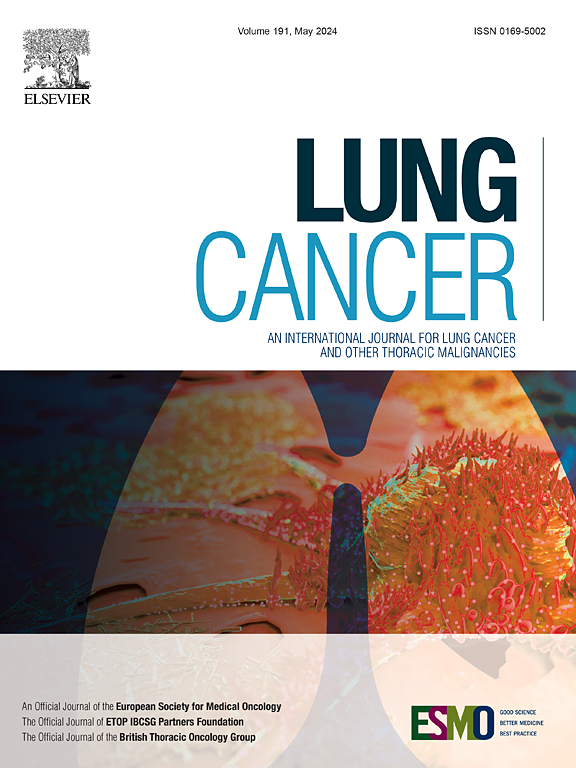Phase III study of ramucirumab plus docetaxel versus atezolizumab for previously treated PD-L1 low or negative advanced non-small-cell lung cancer: WJOG10317L study
IF 4.4
2区 医学
Q1 ONCOLOGY
引用次数: 0
Abstract
Purpose
We aimed to compare the efficacy and safety of docetaxel plus ramucirumab and atezolizumab as second-line treatment for programmed death-ligand 1 (PD-L1)-negative or low advanced non-small-cell-lung cancer (NSCLC) after platinum-based chemotherapy.
Patients and methods
This multicenter randomized phase III study enrolled patients with advanced NSCLC who had progressed during or after first-line platinum-based chemotherapy. Patients were allocated randomly (1:1) to receive atezolizumab (arm A) or docetaxel plus ramucirumab (arm B) every 3 weeks. The primary endpoint was overall survival (OS).
Results
This study was activated in April 2018 and closed in March 2020 due to slow accrual. Seventy eligible patients were enrolled from 26 institutions, including 36 patients in arm A and 34 in arm B. The median OS (median follow-up, 24.2 months) were 17.1 and 15.8 months (HR = 1.508, 95 % confidence interval (CI), 0.86–2.65; P = 0.23), respectively. The 2-year OS rates were 42.8 % (95 % CI, 26.2 %–58.4 %) and 19.4 % (95 %CI, 7.5–35.3), the objective response rates (ORRs) were 5.6 % and 35.3 % (P = 0.002), and the median progression-free survival (PFS) were 1.5 and 5.5 months (P = 0.005), respectively. The crossover rates were 55.6 % and 64.7 %, and the median times from randomization to progression or death post-crossover were 12.9 and 9.1 months. Grade ≥ 3 toxicities included neutropenia (2.8 %/17.6 %), thrombocytopenia (2.8 %/8.8 %), anorexia (2.8 %/5.9 %), febrile neutropenia (0 %/5.9 %), and hypertension (2.8 %/8.8 %).
Conclusions
OS was similar in both arms, but docetaxel plus ramucirumab resulted in favorable ORR and PFS. The 2-year OS rates suggested that atezolizumab might enhance the efficacy of post-study cytotoxic chemotherapy; however, interpretation of the data was limited by the small sample size.
ramucirumab + docetaxel vs . atezolizumab治疗PD-L1低或阴性晚期非小细胞肺癌的III期研究:WJOG10317L研究
目的:比较多西他赛联合ramucirumab和atezolizumab作为程序性死亡配体1 (PD-L1)阴性或低晚期非小细胞肺癌(NSCLC)铂基化疗后二线治疗的疗效和安全性。患者和方法这项多中心随机III期研究纳入了在一线铂类化疗期间或之后进展的晚期NSCLC患者。患者被随机分配(1:1),每3周接受阿特唑单抗(A组)或多西他赛加ramucirumab (B组)治疗。主要终点是总生存期(OS)。本研究于2018年4月启动,由于累积缓慢,于2020年3月结束。来自26个机构的70例符合条件的患者入组,其中A组36例,b组34例。中位OS(中位随访24.2个月)分别为17.1和15.8个月(HR = 1.508, 95%可信区间(CI), 0.86-2.65;P = 0.23)。2年OS率分别为42.8% (95% CI, 26.2% - 58.4%)和19.4% (95% CI, 7.5-35.3),客观缓解率(orr)分别为5.6%和35.3% (P = 0.002),中位无进展生存期(PFS)分别为1.5个月和5.5个月(P = 0.005)。交叉率分别为55.6%和64.7%,交叉后从随机化到进展或死亡的中位时间分别为12.9个月和9.1个月。≥3级毒性包括中性粒细胞减少症(2.8% / 17.6%)、血小板减少症(2.8% / 8.8%)、厌食症(2.8% / 5.9%)、发热性中性粒细胞减少症(0% / 5.9%)和高血压(2.8% / 8.8%)。结论两组的sos相似,但多西紫杉醇联合ramucirumab可获得良好的ORR和PFS。2年OS率表明,atezolizumab可能会提高研究后细胞毒性化疗的疗效;然而,对数据的解释受到样本量小的限制。
本文章由计算机程序翻译,如有差异,请以英文原文为准。
求助全文
约1分钟内获得全文
求助全文
来源期刊

Lung Cancer
医学-呼吸系统
CiteScore
9.40
自引率
3.80%
发文量
407
审稿时长
25 days
期刊介绍:
Lung Cancer is an international publication covering the clinical, translational and basic science of malignancies of the lung and chest region.Original research articles, early reports, review articles, editorials and correspondence covering the prevention, epidemiology and etiology, basic biology, pathology, clinical assessment, surgery, chemotherapy, radiotherapy, combined treatment modalities, other treatment modalities and outcomes of lung cancer are welcome.
 求助内容:
求助内容: 应助结果提醒方式:
应助结果提醒方式:


